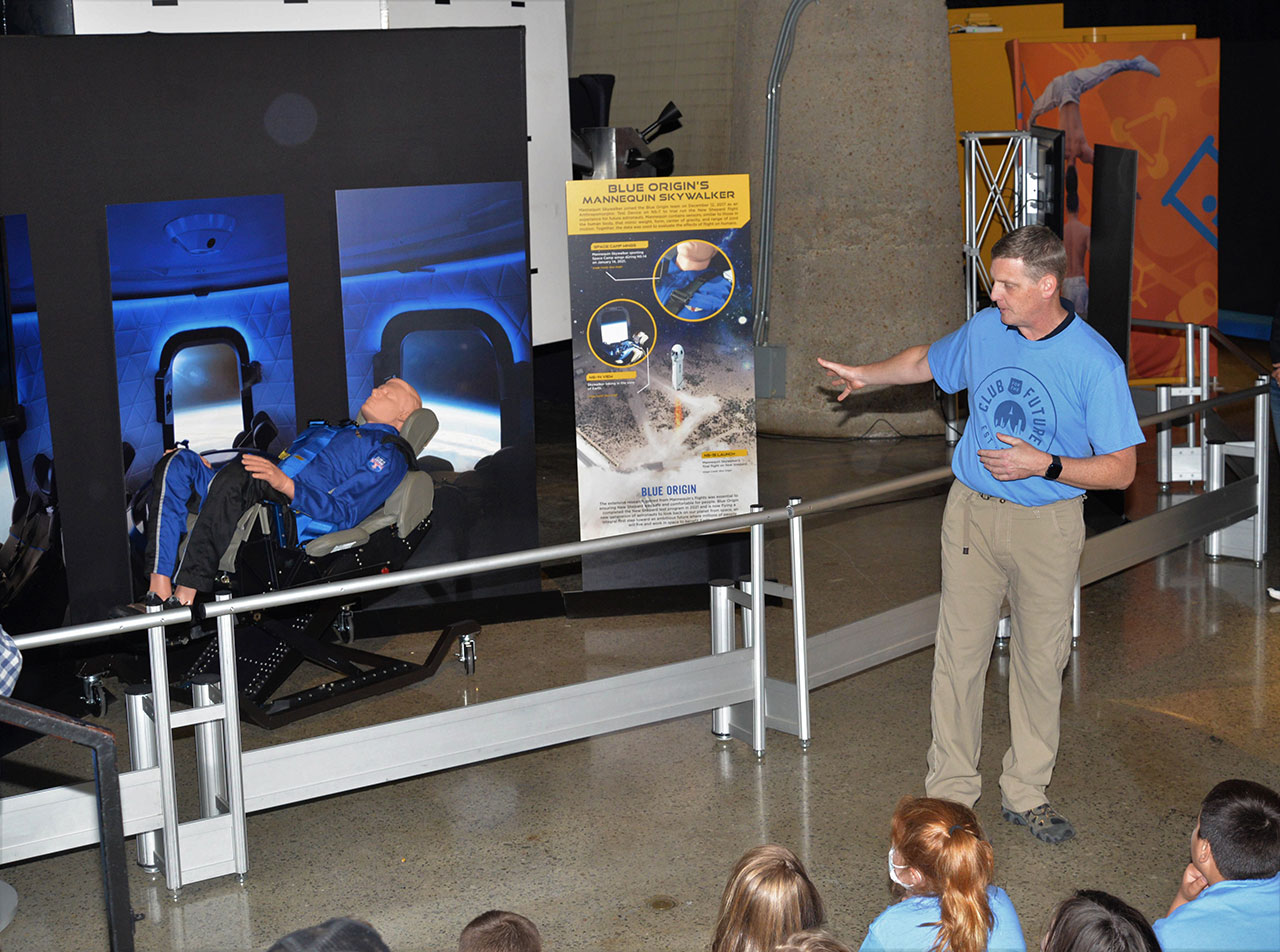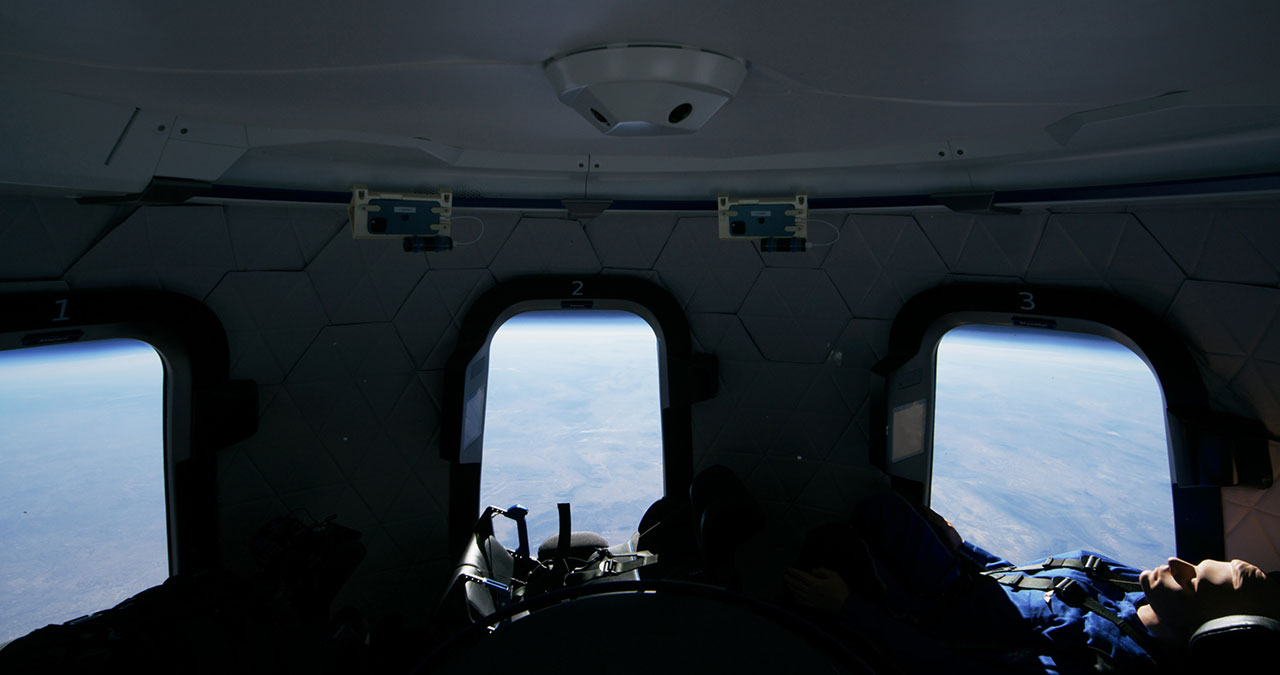Blue Origin's 'Mannequin Skywalker' goes on display at Space Camp

The first passenger to fly with Blue Origin on not just one, but multiple flights into space has now retired to the home of U.S. Space Camp.
"Mannequin Skywalker," an anthropometric test device (ATD, or instrumented dummy) used to collect data about the passenger experience on Blue Origin's New Shepard launch vehicle, was revealed on display at the U.S. Space & Rocket Center in Huntsville, Alabama on Friday (Oct. 29). Mannequin was named by employees of the commercial spaceflight company after the "Star Wars" character Anakin Skywalker.
"We used these kind of devices in our test campaign to measure the stresses on the human body, to test our seat design, to look at all of the forces that they are going to be subjected to and to help us validate our modeling and simulation," Kevin Sproge, CrewMember 7 and chief astronaut trainer at Blue Origin, said in a video interview released by the rocket center.
Later, Vader! Watch Blue Origin fly 'Mannequin Skywalker' to space and back
"We actually had two Mannequin Skywalkers in our test program," Sproge said. "We had one that was fully instrumented on the inside and then this Mannequin Skywalker was instrumented on the outside."
Blue Origin is keeping the other Mannequin to fly again as the company continues to refine its passenger seat design.
The rocket center's exhibit, which was revealed in front of an audience including students from the Boys & Girls Club in Ardmore, Alabama, displays the ATD and its flown seat set against a black backdrop and three photos arranged to form the appearance of the interior of the New Shepard crew cabin during a suborbital spaceflight. A descriptive panel to one side provides details about the dummy, its history and Blue Origin.
Breaking space news, the latest updates on rocket launches, skywatching events and more!
"He is wearing a weight vest so we can test for a heavier weight astronaut," said Sproge.
The Mannequin Skywalker on display launched three times into space, beginning with the seventh flight of New Shepard (NS-7) in 2017. On its second mission, NS-14 in January of this year, it gained a pair of Space Camp wings, which it also wears in the exhibit. The ATD's final flight was in April on NS-15.
"He went above the internationally-recognized definition of space, which is 100 kilometers or 62 miles or about 326,000 feet. So Mannequin went up to about 351,000 feet on his New Shepard flight and has earned the designation as a non-human astronaut," Sproge told the members of the Boys & Girls Club.
On the next flight (NS-16) following this Mannequin Skywalker's retirement, Blue Origin launched its first human crew, including the company's founder Jeff Bezos. The company has since flown a second crew, including "Star Trek" actor William Shatner. A third passenger flight is planned for December.
The Mannequin Skywalker exhibit is in addition to a $1 million donation to Space Camp by Club for the Future, the non-profit organization founded by Blue Origin.
"Club for the Future is so proud to partner with Space Camp and the U.S. Space & Rocket Center because it is one of the world's foremost authorities not just in space, but in space education," said Josef Reinke, director of Club for the Future. "There are thousands and thousands of kids who have not only dreamed of going to Space Camp, but the ones who do come here really go on to live meaningful lives and pursue really interesting careers."
"We want students to come work with us, and we want to work with them, and aerospace companies all over so they can honestly pick up where we are leaving off," Reinke said. "We need kids to really read what has been done and then go invent the future.”
Follow collectSPACE.com on Facebook and on Twitter at @collectSPACE. Copyright 2021 collectSPACE.com. All rights reserved.

Robert Pearlman is a space historian, journalist and the founder and editor of collectSPACE.com, a daily news publication and community devoted to space history with a particular focus on how and where space exploration intersects with pop culture. Pearlman is also a contributing writer for Space.com and co-author of "Space Stations: The Art, Science, and Reality of Working in Space” published by Smithsonian Books in 2018.
In 2009, he was inducted into the U.S. Space Camp Hall of Fame in Huntsville, Alabama. In 2021, he was honored by the American Astronautical Society with the Ordway Award for Sustained Excellence in Spaceflight History. In 2023, the National Space Club Florida Committee recognized Pearlman with the Kolcum News and Communications Award for excellence in telling the space story along the Space Coast and throughout the world.



